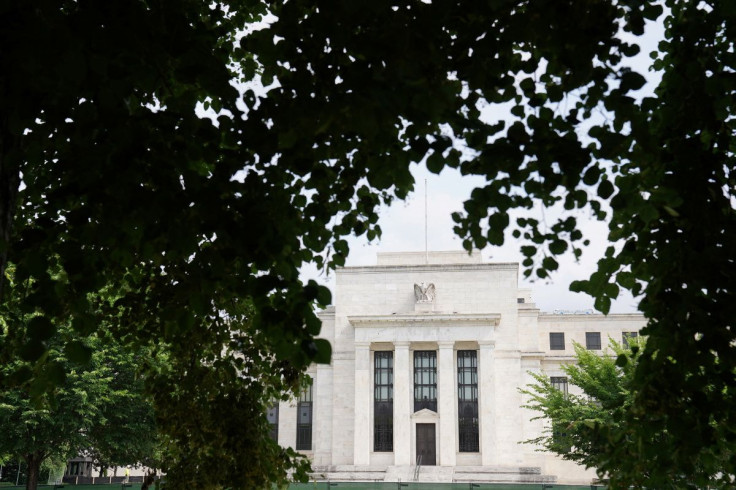Fed Vows 'Unconditional' Inflation War, Says Soft Landing Still Possible

The Federal Reserve, fresh from its biggest interest rate hike in more than a quarter of a century, signaled on Friday it will not let anything stand in the way of its battle to bring down the searing inflation that's punishing American households.
"The Committee's commitment to restoring price stability - which is necessary for sustaining a strong labor market - is unconditional," the Fed said in its twice-yearly monetary policy report to Congress, referring to the U.S. central bank's rate-setting Federal Open Market Committee.
Fed Chair Jerome Powell will testify in Congress next week, updating lawmakers on the Fed's plans to fight 40-year high inflation while also pursuing maximum employment, its two sometimes conflicting jobs.
The central bank on Wednesday raised the range for its policy rate by 75 basis points to 1.50%-1.75% and published forecasts showing most policymakers support lifting borrowing costs further this year to perhaps 3.4%, and higher in 2023. Economists say such sharp increases could spark a recession.
The report's use of the word "unconditional" suggests that the Fed is willing to risk just that in order to avoid what it sees as a far worse situation where inflation gets out of control and exerts far more damaging long-term harm.
On Friday - the first day that Fed rules allow any policymaker other than Powell to publicly air their views following a policy meeting - St. Louis Fed President James Bullard said he believes both the Fed and the European Central Bank will be able to avoid causing a deep recession with their rate hikes.
"The Fed and the ECB have considerable credibility, suggesting that a soft landing is feasible in the U.S. and the euro area if the post-pandemic regime shift is executed well," Bullard said at the Barcelona School of Economics Summer Forum.
That's different, he noted, from what happened the last time the Fed fought inflation at these levels, under former Fed Chair Paul Volcker in the 1980s. Volcker's aggressive tightening caused not one but two recessions.
"The Volcker disinflation was costly, but it was not credible initially - Volcker had to earn credibility," said Bullard, who has been a vocal backer of the increasingly aggressive actions the Fed has taken since March, when it raised its benchmark overnight interest rate by a quarter of a percentage point, and followed that up with a half-percentage-point increase in May and the 75-basis-point hike on Wednesday.
'PRUDENT STRATEGY'
Minneapolis Fed President Neel Kashkari, in an essay published on the regional bank's website, said he supported this week's rate decision and could support another similar-sized hike in July, but said the Fed should be "cautious" about doing too much too fast.
"A prudent strategy might be, after the July meeting, to simply continue with 50-basis-point hikes until inflation is well on its way down to 2 percent," Kashkari said. "Taking a steady approach to driving long real rates higher might help us avoid tightening more than is necessary to restore price stability, while ensuring that we do enough."
Powell earlier this week said in July policymakers will likely be choosing between a half-point hike or another 75 basis-point one, but said such bigger hikes won't be "common."
Traders in futures tied to the Fed's policy rate are currently pricing in a year-end range of 3.5%- 3.75%, which equates to an average increase of 50 basis points at each of the Fed's remaining four meetings this year.
One difficulty facing the Fed is that many of the factors driving inflation, and will determine the strength of the labor market going forward, are beyond the central bank's control.
"Further risks to global supply chains abound," the Fed noted in the semi-annual monetary policy report, underscoring that sentiment. Still, the labor market remains strong, with unemployment at 3.6%, giving the economy what policymakers hope is some buffer against the pain of rising interest rates.
Fed policymakers on Wednesday projected unemployment rising to 4.1% by 2024, as growth slows to 1.9% and inflation falls to 2.2%, a scenario Powell said would be hard to achieve but represents a "soft-ish" landing.
On Friday the New York Fed published results from an economic model that it uses for its own forecasting that shows chances of a hard landing - defined as one quarter over the next 10 where GDP shrinks by at least 1% - are about 80%. For more on what a recession is, see.
Kansas City Fed President Esther George, who dissented in this week's policy decision, said on Friday that she thought a bigger move added to policy uncertainty at the same time the Fed was also beginning to shrink its massive balance sheet.
Her objection to Wednesday's policy action notwithstanding, George said she shares the rate-setting committee's "strong commitment to bring down inflation to achieve our mandate for long-run price stability."
Inflation, as measured by the Personal Consumption Expenditures Price Index, is running at more than three times the Fed's 2% target.
© Copyright Thomson Reuters 2024. All rights reserved.




















